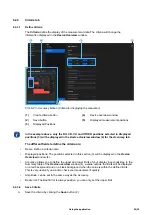
11.
Glossary
Escapement:
The escapement is a mechanism usually placed between the energy source (spring, weight,
etc.) and the regulating organ. The purpose of the escapement is to maintain and count the
oscillations of the balance wheel of a watch. It allows the transmission of time information from
a regulating device (balance wheel) to the device to be regulated (the hands of a watch, for
example), and to supply the regulating device with energy.
Frequency:
The frequency is the number of oscillations that the pendulum makes in time. The Accuracy
Windows application expresses the frequency in beats per hour [b/h]. By default, the beat
frequency of a watch is automatically detected within 2 seconds. The range covers the most
common beat rates, from 2Hz (14'400b/h) to 10Hz (72'000b/h). The user can manually set the
frequency and thus disable the frequency detection.
Integration time:
Due to phenomenons related to the acoustic physics, the rate accuracy must be averaged over
a period called the integration time, expressed in seconds [s]. The integration time values cover
a range from 2s to 240s. The lower the time integration, the less stable the measurement.
However, a low integration time allows the measurement to show more detailed fluctuations.
Basically, you would use a long integration time (30 or 60s) for inaccurate vintage watches or if
you use the Accuracy Pro in a noisy environment. If the watch is stable, accurate, and you are
doing the measurement in a calm environment, you can use a lower integration time. However,
we highly recommend to always use an integration time higher than 10s.
Gain:
As all watch signals are different, the Accuracy Pro integrates an AGC, for Automatic Gain
Control. By default, the gain is set to automatic which means that weak signals are boosted
(Gain > 70%) and strong signals are reduced (Gain < 30%). The AGC is ON until the Measuring
State is reached. By ticking the check box, the user can set a manual gain and thus disable the
AGC.
Lift angle:
The lift angle is the angle in degrees covered by the balance wheel between the first and third
peak of the escapement signal. It is a geometric characteristic, determined by construction and
given by the manufacturer. In the watch industry, the angle of lift is known to be very imprecise:
between 2 movements of the same production, a variation of +/- 3° of the angle of lift is not rare.
As a variation of 1° is equivalent to a variation of about 7° of the amplitude value, this is the
reason why the acoustic measurement of the amplitude is always an estimate. For most
standard watch movements, the angle of lift is about 51°.
Measurement time:
By default, the measurement time is infinite, which means that the measurement will only stop
when the watch reaches its power reserve or if it is removed from the sensor. The user can set
a specific measurement up to 92h. If done, the measurement will automatically stop, with a
message at the top of the window.
Stabilization time:
If set, the stabilization time is a countdown that appears after each change of testing position. It
can be seen as a dead time with no measurement done during that time and serves 2 purposes:
•
When a watch changes of position, it can take some time for the balance wheel to reach its full
work amplitude.
Glossary
35|36
Содержание ONEOF Accuracy Motion
Страница 1: ...Accuracy Motion User Manual ...
Страница 35: ...10 Annexes Annexes 34 36 ...

































